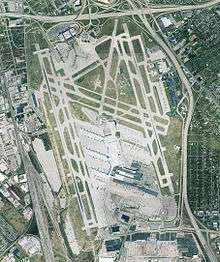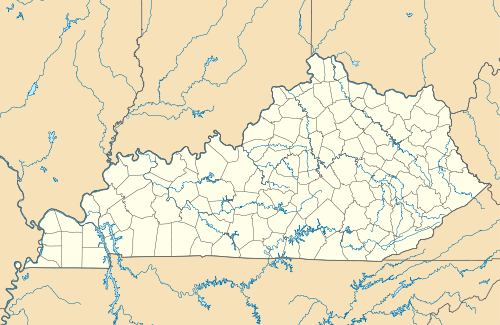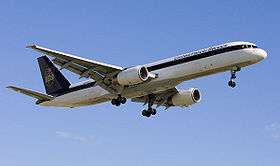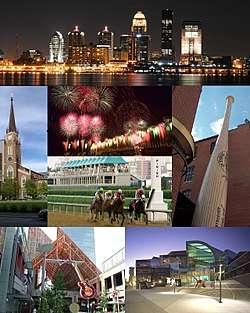Louisville International Airport
| Louisville International Airport Standiford Field | |||||||||||||||||||
|---|---|---|---|---|---|---|---|---|---|---|---|---|---|---|---|---|---|---|---|
 | |||||||||||||||||||
 | |||||||||||||||||||
| Summary | |||||||||||||||||||
| Airport type | Public | ||||||||||||||||||
| Owner/Operator | Louisville Regional Airport Authority (LRAA) | ||||||||||||||||||
| Serves | Louisville, Kentucky | ||||||||||||||||||
| Hub for | UPS Airlines | ||||||||||||||||||
| Elevation AMSL | 501 ft / 153 m | ||||||||||||||||||
| Coordinates | 38°10′27″N 085°44′11″W / 38.17417°N 85.73639°WCoordinates: 38°10′27″N 085°44′11″W / 38.17417°N 85.73639°W | ||||||||||||||||||
| Website |
www | ||||||||||||||||||
| Map | |||||||||||||||||||
 SDF Location of airport in Kentucky / United States  SDF SDF (the US) | |||||||||||||||||||
| Runways | |||||||||||||||||||
| |||||||||||||||||||
| Statistics (2017) | |||||||||||||||||||
| |||||||||||||||||||
Louisville International Airport (IATA: SDF, ICAO: KSDF, FAA LID: SDF) is a public and military use public airport centrally located in the city of Louisville in Jefferson County, Kentucky, United States. The airport is situated on approximately 1,500 acres (6.1 km2) and has three runways. Its IATA airport code, SDF, is based on the airport's former name, Standiford Field. Although it currently does not have regularly-scheduled international passenger flights, it is a port of entry, as it handles numerous international cargo flights.[4]
Over 3.2 million passengers and over 4.7 billion pounds (2,350,000 t) of cargo passed through the airport as of 2014.[2] It is also the third-busiest in the United States in terms of cargo traffic, and seventh-busiest for such in the world.[5]
The airport is included in the National Plan of Integrated Airport Systems for 2011–2015, which categorized it as a "primary commercial service" airport since it has over 10,000 passenger boardings (enplanements) per year.[6] As per Federal Aviation Administration records, the airport had 1,650,707 enplanements in 2011, a decrease of 0.02% from 1,651,037 in 2010.[7]
The airport is home to Worldport, the worldwide hub of UPS. The Kentucky Air National Guard's 123d Airlift Wing operates C-130 transport aircraft from the co-located Louisville Air National Guard Base.
History
Standiford Field was built by the Army Corps of Engineers in 1941 on a parcel of land south of Louisville that was found not to have flooded during the Ohio River flood of 1937. It was named for Dr. Elisha David Standiford, a local businessman and politician, who was active in transportation issues and owned part of the land. The field remained under Army control until 1947, when it was turned over to the Louisville Air Board for commercial operations.[8]
Until around 1947 Bowman Field was Louisville's main airport. For many years passenger traffic went through the small brick Lee Terminal at Standiford Field. Today's more modern and much larger facilities were built in the 1980s. Most of the Lee Terminal was later torn down.
The April 1957 Official Airline Guide shows 45 weekday departures on Eastern Airlines, 19 American, 9 TWA, 4 Piedmont and 2 Ozark. Scheduled jet flights (Eastern 720s to Idlewild) began in January–February 1962. Parallel runways, needed for expanded UPS operations, were part of an airport expansion plan begun in the 1980s.
When Louisville International Airport was built by the U.S. Army Corp of Engineers in 1941, it had one 4,000-foot (1,200 m) runway and was called Standiford Field. The airfield opened to the public in 1947 and all commercial service from Bowman Field moved to Standiford Field. American, Eastern, and TWA were the first airlines and had 1,300 passengers a week. The airlines used World War II barracks on the east side of the field until May 25, 1950, when a proper terminal opened. Lee Terminal could handle 150,000 passengers annually and included 6 new gates, which increased terminal space to 114,420 square feet (10,630 m2). The three runways (1, 6 and 11) were all 5000 ft.
In 1970 the terminal again expanded; the main lobby was extended and the 33,000-square-foot (3,100 m2) Delta Air Lines concourse was built.[8]
The 1980s brought plans for a new terminal, the Louisville Airport Improvement plan (LAIP). Construction of a new landside terminal designed by Bickel-Gibson Associated Architects Inc. began, costing $35 million with capacity for nearly 2 million passengers in 1985.[9] Most of the improvements began construction in the 1990s and the airport was totally renewed. During the 1990s Southwest Airlines passenger boardings increased 97.3 percent. In 1995 the airport's name was changed from Standiford Field to Louisville International Airport. Around that time SDF got two new parallel runways: runway 17L/35R, 8,578 feet (2,615 m) long and runway 17R/35L, 11,887 feet (3,623 m); both are 150 feet (46 m) wide. The Kentucky Air National Guard moved its base to SDF with 8 military aircraft; a new UPS air mail facility, new corporate hangars, a 4 level parking garage and a new control tower were also added. A new FBO was added, run by Atlantic Aviation and managed by Michael Perry. In 2005 a $26 million terminal renovation designed by Gensler Inc. was completed.[10] Yearly passenger enplanements are about 1.7 million and are forecast to increase in the next 5 years. Louisville International is served by several airlines including Allegiant, American, Delta, OneJet, Southwest, United, FedEx and UPS.[11]
Facilities and aircraft
Louisville International-Standiford Field covers 1,500 acres (610 ha) at an elevation of 501 feet (153 m) above mean sea level. It has three concrete runways: 17R/35L is 11,887 by 150 feet (3,623 x 46 m); 17L/35R is 8,578 by 150 feet (2,615 x 46 m); 11/29 is 7,250 by 150 feet (2,210 x 46 m).[1] Runway 17R and 17L will be lengthened to 13,000 feet and 10,500 feet respectively within the next 2–3 years as an extra margin of safety for the new generation of cargo and passenger super-jets.
In the year ending May 31, 2018, the airport had 167,470 aircraft operations, an average of 459 per day: 76% scheduled commercial, 15% air taxi, 7% general aviation, and 2% military. 36 aircraft were then based at this airport: 75% jet, 22% military, and 3% single-engine.[1] The terminal is named the Jerry E. Abramson Terminal Building.
Airlines and destinations
Passenger
| Airlines | Destinations | Refs |
|---|---|---|
| Allegiant Air | Fort Lauderdale, Las Vegas, Orlando/Sanford, Punta Gorda (FL), St. Petersburg/Clearwater Seasonal: Fort Walton Beach, Jacksonville, Myrtle Beach, Savannah | [12] |
| American Eagle | Charlotte, Chicago–O'Hare, Dallas/Fort Worth, Miami, New York–LaGuardia, Philadelphia, Washington–National | [13] |
| Delta Air Lines | Atlanta | [14] |
| Delta Connection | Detroit, Minneapolis/St. Paul, New York–LaGuardia Seasonal: Atlanta, Orlando | [14] |
| Frontier Airlines | Seasonal: Austin, Denver, Orlando (begins November 15, 2018) | [15] |
| Southwest Airlines | Baltimore, Chicago–Midway, Dallas–Love (begins January 7, 2019), Denver, Houston–Hobby, Las Vegas, Orlando, Phoenix–Sky Harbor, Tampa | [16] |
| United Express | Chicago–O'Hare, Denver, Houston–Intercontinental, Newark, Washington–Dulles | [17] |
Cargo
Statistics
Airline market share
| Carrier | Passengers (arriving and departing) |
|---|---|
| Southwest | 952,000(27.18%) |
| Delta | 637,000(18.18%) |
| Republic | 385,000(10.98%) |
| PSA | 303,000(8.65%) |
| Allegiant | 206,000(5.88%) |
| Other | 1,021,000(29.14%) |
Top destinations
| Rank | City | Passengers | Carriers |
|---|---|---|---|
| 1 | Atlanta, Georgia | 320,000 | Delta |
| 2 | Chicago–O'Hare, Illinois | 147,000 | American, United |
| 3 | Charlotte, North Carolina | 146,000 | American |
| 4 | Chicago–Midway, Illinois | 132,000 | Southwest |
| 5 | Baltimore, Maryland | 112,000 | Southwest |
| 6 | Dallas/Fort Worth, Texas | 110,000 | American |
| 7 | Denver, Colorado | 82,000 | Southwest, United |
| 8 | Detroit, Michigan | 78,000 | Delta |
| 9 | New York–LaGuardia, New York | 58,000 | American, Delta |
| 10 | Minneapolis/St. Paul, Minnesota | 56,000 | Delta |
Annual traffic
| Year | Passengers | Year | Passengers |
|---|---|---|---|
| 2017 | 3,474,340 | 2009 | 3,254,657 |
| 2016 | 3,346,545 | 2008 | 3,678,919 |
| 2015 | 3,359,472 | 2007 | 3,812,299 |
| 2014 | 3,355,811 | 2006 | 3,637,795 |
| 2013 | 3,404,080 | 2005 | 3,696,524 |
| 2012 | 3,365,115 | 2004 | 3,399,712 |
| 2011 | 3,392,745 | 2003 | 3,291,586 |
| 2010 | 3,343,968 |
Operations
Louisville International Airport is home to a Republic Airline maintenance complex, capable of holding nine planes.
In addition to commercial air traffic there is a significant amount of general aviation activity at Louisville International Airport, for business travel and other purposes such as the Kentucky Derby.[18]
Worldport

Worldport is the worldwide air hub for UPS (United Parcel Service) located at the Louisville International Airport. Although UPS has had a hub at Louisville since 1980, the term was not used officially by the company until 2002, after a $1 billion, five-year expansion.[19] Previously, the project was named Hub 2000. The facility is currently the size of 5.2 million square feet (48 ha; 80 football fields) and capable of handling 115 packages a second, or 416,000 per hour.[20] With over 20,000 employees, UPS is one of the largest employers in both the city of Louisville and the Commonwealth of Kentucky as a whole. The facility, which serves all of the company's major international and domestic hubs, mainly handles express and international packages and letters.

A one-million-square-foot expansion was completed in spring 2006 to integrate heavy freight into the UPS system. The expansion was prefaced by the purchase of Menlo Worldwide Forwarding, formerly Emery Worldwide. The new facility, designated Worldport Freight Facility (HWP), went online in April 2006 and was the first of the company's regional hubs to begin integrating the Menlo volume into the system. Menlo's facility in Dayton, Ohio, was taken offline in June 2006.
In May 2006, UPS announced that for the third time in seven years it would significantly expand its Worldport hub, with a second billion-dollar investment. The second expansion was completed in April 2010, with the facility now measuring 5,200,000 square feet (480,000 m2), with a perimeter of 7.2 miles (11.6 km). The plan was for more than one million square feet to be added to its existing facility, with another 334,500-square-foot (31,080 m2) of space to be renovated with new technology and equipment. Worldport sorting capacity was to expand from 300,000 packages per hour to 416,000 packages per hour. Additionally, several ramps at the Louisville International Airport were to be built or altered bringing a total increase of just over 3,000,000 square feet (280,000 m2).
Since many of the jobs are part-time and overnight, UPS has hired mostly college students by offering both nationwide tuition reimbursement and a special program called Metropolitan College, in which University of Louisville and Jefferson Community and Technical College students who work part-time overnight can receive 100% tuition reimbursement.
Worldport was featured on an episode of the television show Ultimate Factories in June 2008.
Accidents and incidents
- On December 21, 1978, TWA Flight 541 from Louisville to Kansas City International Airport was hijacked by 17-year-old Robin Oswald to Williamson County Regional Airport in Illinois in attempt to secure the release of Garrett Brock Trapnell who was serving time at United States Penitentiary, Marion, for the January 28, 1972, hijacking of TWA Flight 2 from Los Angeles to New York. Oswald's mother, Barbara Oswald, was killed May 24, 1978, after hijacking a helicopter in an attempt to rescue Trapnell (and Martin J. McNally, who was serving time for the June 23, 1972, hijacking of a St. Louis-Tulsa American Airlines flight). Robin Oswald surrendered after 10 hours at the Williamson airport.[21][22]
- On August 14, 2013, UPS Airlines Flight 1354 registration N155UP from Louisville to Birmingham, Alabama crashed while attempting to land on Runway 18 at Birmingham–Shuttlesworth International Airport. Both pilots were killed.
See also
References
- 1 2 3 FAA Airport Master Record for SDF (Form 5010 PDF). Federal Aviation Administration. effective November 15, 2012.
- 1 2 3 4 "RITA | BTS | Transtats - Louisville, KY: Louisville International-Standiford Field (SDF)". March 2014. Retrieved July 6, 2014.
- 1 2 "Reports and Statistics". Louisville Regional Airport Authority. Archived from the original on April 6, 2015.
- ↑ US Customs and Border Patrol Archived October 30, 2012, at the Wayback Machine.
- ↑ "Table 2 – TOTAL CARGO TRAFFIC 2013 - Preliminary World Airport Traffic and Rankings 2013 - High Growth Dubai Moves Up to 7th Busiest Airport - Mar 31, 2014". Airports Council International. March 31, 2014. Retrieved July 6, 2014.
- ↑ "2011–2015 NPIAS Report, Appendix A" (PDF). faa.gov. Federal Aviation Administration. October 4, 2010. Archived from the original (PDF, 2.03 MB) on September 27, 2012.
- ↑ "Enplanements for CY 2011" (PDF, 1.7 MB). faa.gov. Federal Aviation Administration. October 9, 2012.
- 1 2 "History". Louisville International Airport. Retrieved 9 August 2016.
- ↑ "Engineering News-Record". 209. McGraw-Hill. Retrieved June 14, 2012.
- ↑ Adams, Brent (June 17, 2002). "Capital projects at Louisville Airport proceed; officials keep eye on security costs". Louisville Business First. archives.californiaaviation.org. Retrieved July 26, 2016.
- ↑ "Airlines". Louisville International Airport. Archived from the original on August 18, 2016. Retrieved August 9, 2016.
- ↑ "Allegiant Air". Retrieved 7 January 2017.
- ↑ "Flight schedules and notifications". Retrieved 7 January 2017.
- 1 2 "FLIGHT SCHEDULES". Retrieved 7 January 2017.
- ↑ "Seasonal Routes". Retrieved 27 December 2017.
- ↑ "Check Flight Schedules". Retrieved 7 January 2017.
- ↑ "Timetable". Retrieved 7 January 2017.
- ↑ Epstein, Curt (May 5, 2015). "Derby, Boxing Match Fuel Atlantic's Best Day Ever". Aviation International News. Retrieved May 6, 2015.
- ↑ UPS Pressroom: Press Release Archive
- ↑ UPS Worldport Facts
- ↑ Keve, Paul W. (August 1, 1995). Prisons and the American Conscience: A History of U.S. Federal Corrections. SIU Press. p. 173. ISBN 9780809320035. Retrieved May 17, 2012.
- ↑ O'Neil, Tim (June 25, 2011). "A Look Back: Airline hijacking at Lambert in 1972 turns bizarre". St. Louis Post Dispatch. Retrieved May 17, 2012.
External links
| Wikimedia Commons has media related to Louisville International Airport. |
- Louisville International Airport, official site
- Kentucky Air National Guard, official web site
- Standiford Field ANG / Louisville International Airport at GlobalSecurity.org
- Aerial image from USGS The National Map
- FAA Airport Diagram (PDF), effective October 11, 2018
- FAA Terminal Procedures for SDF, effective October 11, 2018
- Resources for this airport:
- AirNav airport information for KSDF
- ASN accident history for SDF
- FlightAware airport information and live flight tracker
- NOAA/NWS latest weather observations
- SkyVector aeronautical chart for KSDF
- FAA current SDF delay information

